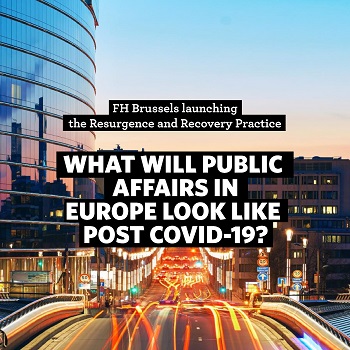Transport
Rising environmental pressure, from both the public and the policy (European Green Deal) fronts, as well as the COVID-19 crisis, are continuing to expose the transport sector to titanic challenges. These challenges are only accelerating a process towards a more sustainable transport system that was already underway.
Transport is one of the few sectors that has seen its greenhouse emissions rise since 1990, and currently accounts for roughly 25% of the EU’s total GHG emissions, a share that could rapidly increase without additional measures.
Decarbonising the entire transport system, from light duty vehicles to aviation and shipping, is therefore a critical part of the EU’s climate-neutrality objective. Similar to so many other sectors, this hinges on implementing the twin transition of digitalisation and sustainability.
The transport and mobility sectors are key drivers of European competitiveness and R&D spending: from a highly innovative automotive manufacturing industry to a logistics sector playing a critical role in supporting global supply chains in a globally integrated market.
The current crisis is forcing new questions about global supply chains and reshoring trends are emerging on the political and business agendas, yet transport remains an important cog in the global economy and simply cannot be addressed in isolation.
More than just a focus on GHG emissions, the European Green Deal includes a clear objective for a zero-pollution Europe, with air quality a fundamental pillar of the vision for a cleaner society. For mobility policy this means an objective of cutting transport GHG emissions by 90% by 2050 (compared to 1990 levels) and eliminating emissions of air pollutants entirely. Horizontally, this will be primarily achieved via:
- Aligning the Energy Taxation Directive to the new climate ambitions of the EU, in order, for example, to enable alternative fuels, such as advanced biofuels and hydrogen, to better compete with conventional fuels, and to close existing exemptions (such as for kerosene) and loopholes that are not aligned with the EU’s climate agenda.
- Presenting a Strategy on Sustainable and Smart Mobility by providing concrete signals to each transport mode, harness digitalisation as a means to improve efficiency, streamline the user-pays principle across transport modes and identifying infrastructural needs to achieve a higher degree of multimodality.
- Extending the EU Emission Trading System (EU ETS) to maritime and aviation emissions (reducing the free allowances to airlines) and, potentially, to road transport.
Road
Pushes to lower the environmental footprint of transport have been triggering changes in the sector for many years. The Juncker Commission launched three major initiatives during its mandate to address social and environmental challenges especially in road mobility.
Firstly, updated emissions standards were agreed for passenger cars and commercial vehicles, as well as a brand new framework for CO2 emissions standards for Heavy Duty Vehicles In addition, a new Eurovignette regulation was proposed, in order to streamline the polluter pays principle into road charges and dynamic pricing via congestion charges. Finally, new legislation dealing with driving and resting periods as well as posting of road transport workers aims to provide more adequate social protection for a highly mobile workforce.
The current Von der Leyen Commission has made the fight against climate change its primary objective, publishing the European Green Deal at the end of 2019. It seeks to mainstream sustainability across all policies and to adapt legislation where necessary to remove obstacles to reaching the climate-neutrality objective by 2050. For the road sector, this includes:
- Modernising road and congestion charging to enable more dynamic, distance-based pricing through the Eurovignette and European Electronic Tolling Service instruments, for both heavy-duty and passenger vehicles.
- Revising the Alternative Fuels Infrastructure Directive (AFID) to ensure there is consistency amongst Member States on the development of such infrastructure to foster the uptake of alternative fuels (including hydrogen).
- Proposing a new Euro 7 pollutant emission standard for all cars, vans, lorries and buses comprise real-time measurement of emissions to ensure that vehicles on EU roads are clean over their whole lifetime.
- Revising the 2030 CO2 standards for cars and vans to further stimulate the deployment of zero- and low-emission vehicles.
Aviation
In 2016, the European Commission adopted the Aviation Strategy for Europe to improve the EU’s connectivity with third countries, increase capacity, spur innovation, reduce emissions and accommodate new technologies into the EU’s aviation eco-system, such as drones. Much of this agenda remained under way until recently.
Meanwhile, COVID-19 has prompted the most profound crisis in the aviation industry since its inception. The Commission responded by adopting a temporary state aid framework, in order to enable Member States to provide liquidity and tailored support packages.
As a result of the sudden collapse of the air travel market, much of the existing aviation agenda has been thrown into question, with economic analyses underpinning future legislation (such as on airport capacity, charges and slot allocation) having quickly become obsolete.
At the same time, the crisis provides a unique opportunity to address longstanding challenges: improve capacity at airports and in airspace, modernise air traffic management (through a revised Single European Sky 2+ proposal), accelerate digitalisation and drive efficiency gains. With the influx of state aid to airlines and other actors, the Commission will also be hard-pressed to minimise distortion to competition, while simultaneously enabling the state aid framework to deal with future shocks.
While COVID-19 is leading to short-term depressed demand, policymakers will be looking for measures to ensure emissions do not return to previous levels. The EU relies on a so-called ‘basket of measures’:
- Improving operational and technical efficiency by advancing the Single European Sky agenda
- Supporting R&D in new aircraft technology, including via the Clean Sky programme
- Decreasing emissions through a sustainable aviation fuels initiative (ReFuelEU) and the expansion of the EU ETS
- Offset emissions by implementing a global market-based measure (CORSIA, the mechanism devised by the International Civil Aviation Organization).
Maritime
The European Commission’s work on maritime issues focuses on safety rules preventing sub-standard shipping, reducing the risks or maritime accidents and minimising the environmental impact of the sector. The overall policy work was set out in 2009 in the Maritime Transport Policy until 2018.
Besides its involvement in the International Maritime Organisation (IMO) and the transposition of binding legislation in maritime issues, the EU has carried out its own legislative processes.
This has led to a set of standards applicable in international waters and specific standards for EU waters, raising concerns among European shipping companies about a competitive disadvantage with respect to counterparts operating outside the scope of EU legislation.
The seminal focus of the Commission currently concerns reducing the environmental footprint of the sector. As part of the European Green Deal, the Commission will extend the EU ETS to the maritime sector and has also launched an initiative to increase the availability of low-carbon fuels in the sector, called ReFuelEU Maritime.
The sector faces more challenges to decarbonize compared to other transport modes, with few alternatives to fossil fuels. The sector is looking now to e-fuels as a way to contribute to the 2050 climate neutrality goal, as electrification is not feasible for commercial shipping in the near future.
Rail
The European Commission work on rail has focused on opening the rail market to competition, improving interoperability and safety of the national networks and the development of infrastructure.
Four legislative packages were launched between 2001 and 2016 in this regard, which resulted in the setup of the European Agency for Railways, the development of passenger rights and safety requirements or the set of common provisions on licensing of railway undertakings and train driver certifications.
The Commission has also sought to move more freight volume to rail as part of its multimodality strategy, with mixed success. Barriers to rail freight market entry continue to pose problems for the competitiveness of the sector, while competition from heavy-duty vehicles remains strong.
The 2011 White Paper on Transport called for shifting 30% of road freight volume carried over more than 300 kilometres to rail and waterborne transport by 2030, but Eurostat indicates that the overwhelming majority – nearly 80% – of the EU’s freight volume is still carried by road.
A 2016 study by the European Parliament Research Service found that more active support from Member States is needed to build the necessary multimodal infrastructure and that further R&D in railway technology is needed to close the innovation gap with the road sector.
For passenger transport, public pressure resulting from the ‘Flygskam’ or flight shame movement, combined with the need to reduce emissions from passenger transport has given a new impetus to cross-border rail corridors and night trains.
The incoming Commission has pledged to make the European railway network a key element of its multimodality strategy to reduce carbon emissions from the sector. It will also explore possibilities to set up a single window for one-stop-shop declaration of freight declarations, which already exists for the maritime sector.
One of the key elements in the strategy to increase the share of rail passengers is improving multimodal travel information to offer smarter and sustainable door-to-door journeys and to improve overall travelling comfort. Furthermore, rail is positioned as a potential beneficiary of the development of hydrogen. In this regard, some experimental trains powered by hydrogen have been developed already in the Netherlands and France.
Our services
How can you capitalise on the opportunities while addressing the challenges? Our team provides a full range of advocacy and communications solutions for engaging with European policymakers:
- Positioning and counsel on the EU transport policy agenda
Our team has built broad expertise across policy areas within and between different modes of transport. Assessing the landscape comprehensively, advising on prioritisation and constantly monitoring the shifting environment are all fundamental to our activities. We help you understand what drives your agenda and identify opportunities and risks to your business.
The transport policy space has seen increasing spillover from related policy areas, such as digitalisation, competition and circular economy. Thanks to FleishmanHillard’s diverse and deep policy expertise across several teams, we can offer you a holistic view about the developing political landscape for your sector.
- Engagement with policymakers
We support you in selecting effective engagement tactics to ensure your voice is heard in Brussels through every step of the policymaking process – whether it is before or after publication of draft legislation, or during its implementation.
Relying on a deep and broad network, FleishmanHillard can help you identify your key audience, set up effective engagement programmes and ensure adequate follow-up.
- Communications, third-party mobilisation and media relations
One of the challenges of an effective advocacy strategy is ensuring complex, technical arguments have political and policy relevance, and are understandable for an audience who are not necessarily experts or familiar with your sector, its challenges or value-add.
FleishmanHillard has extensive experience and expertise on communicating such business challenges to policymakers. Our experts help you to create a compelling narrative about your contribution to the European mobility system, articulate how you can help Europe achieve its policy objectives, and selecting the right channels to disseminate your messages.
Mobilising like-minded players and value-chain partners often helps increasing the effectiveness of an advocacy campaign. Building on a wide network in Brussels, our team can help you build effective alliances to strengthen your case.
Managing a rapidly maturing public European discourse and thus navigating the EU media landscape has also become essential to shaping the narrative about your industry. FleishmanHillard can help you pitch your message to the right audience and engage proactively and reactively with media both in Brussels and in national Member States.
Subscribe to our newsletter to get the latest updates in the transport space!
Transport News & Opinions
-
Bidding farewell to fossil fuels at COP28: How to get it right this time
November 27, 2023











